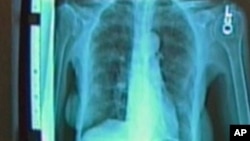Researchers are developing a test using a nasal swab that could help doctors determine whether to order further testing in patients suspected of having lung cancer.
The disease is the deadliest of cancers, according to experts, who say that by the time the cancer is found, it has usually spread.
It has become routine medical practice, particularly in the West, to use a high-tech X-ray, called a CT scan, to see whether current and former smokers are developing the disease.
The problem is CT scans find lung nodules — or growths — in many smokers and former smokers that are not malignant. However, in many cases, doctors can't be certain so more invasive and potentially dangerous biopsies of the nodules are ordered.
A nasal test may change that. Researchers have found that cellular, genetic changes in tissue lining the nose may be present in people with lung cancer.
Biomarkers
Avrum Spira, a doctor of respiratory medicine at Boston University Medical Center, said there is a "field of cancerization" in smokers and former smokers that can help doctors determine whether the growths might be malignant.
"Even though, when you're exposed to tobacco, the cancer usually grows deep in your lungs, the reality is that all of the cells that line your respiratory tract — your nose, your mouth and the windpipe — all those cells are being bathed literally in all the toxins that are being inhaled," Spira said.
Spira said an existing test, called Percepta, can identify the same genetic changes in the tissue of the windpipe that are contained in malignant lung tumors. A positive finding of genetic alterations in the windpipe suggests a suspicious growth.
In a study conducted by Spira and colleagues, researchers wanted to see whether the field of cancerization extended up from the lungs, through the windpipe and into the nose.
They compared the results of bronchial swabs to swabs of the nose to see if the same genetic changes could be detected in the nasal passages. Researchers found that they could.
Investigators identified changes in 30 genes that, taken together, form a biomarker that is highly suggestive of lung cancer.
A study published in the Journal of the National Cancer Institute looked for the biomarker in cells swabbed from the nose. The study involved patients with suspicious lung lesions at centers in North America and Europe.
Among a subset of 130 patients, researchers identified 90 percent of lung cancers in smokers and former smokers who turned out to have cancer.
A test that looks for cancer biomarkers in the nose is preferable to more invasive swabs of the windpipe, according to Spira.
Reassurance, early diagnosis
Spira said that a negative nasal swab test did not mean the patient didn't have a developing lung cancer. The test, however, offers reassurance to patients and doctors, who can then order repeat lung scans and wait to see whether the nodules are early malignancies, Spira said.
"Physicians want to be able to rule out lung cancer," he said. "They are looking to know who can they avoid sending for an unnecessary surgical biopsy. So a negative test here would help do that."
Diagnosing lung cancer early means the tumor can be removed surgically, dramatically increasing a patient's chances of survival.
Investigators plan on conducting a larger clinical study, and hope to have the nasal swab test on the market in the next two to three years.
Spira said drugs are now in development that can reduce a patient's risk of lung cancer. In the future, he said, these drugs could be given to patients who have a positive nasal swab.









